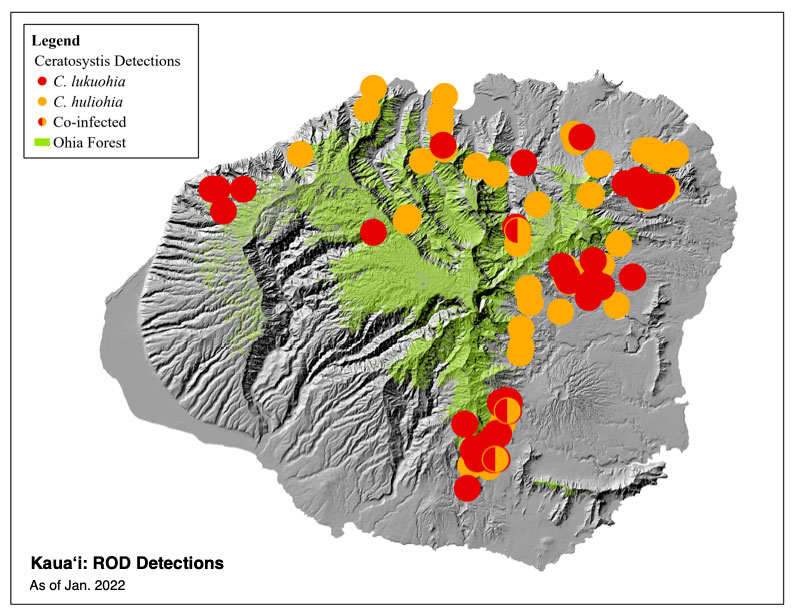
ROD Response
Rapid ʻŌhiʻa Death Response
KISC actively participates on the Kauaʻi Rapid ʻŌhiʻa Death Rapid Response Team to respond, manage, and monitor this disease pathogen. KISC also leads the outreach and education effort on Kauaʻi to raise awareness of the importance of ʻōhiʻa to our everyday lives and the very real threat that Rapid ʻŌhiʻa Death represents.
ʻŌhiʻa (Metrosideros polymorpha), a keystone species in Hawaiʻi’s native forests, faces a new threat in the form of a new fungal disease called Rapid ʻŌhiʻa Death (ROD). First detected on Hawaiʻi Island more than a half-dozen years ago, more than a million ʻōhiʻa on Hawaiʻi island have died from two new fungi, unknown to science before. In 2018, the disease was found for the first time on Kauaʻi in Moloaʻa State Forest Reserve. KISC was actively on-the-ground surveying for and sampling symptomatic trees.
In the Hawaiian culture, the saying I walea ka manu i ka ‘ula o ka lehua translates to “The bird is attracted by the redness of the lehua” and hints at the intimate connection between tree and bird.
A flowering tree in the myrtle family, ‘ōhia is endemic to Hawai‘i. As an early colonizer after a new lava flow, it’s known as a foundational species of the native forests of Hawaiʻi. ‘Ōhi’a is critical to the function of our watershed and the ecology of Hawai‘i. ‘Ōhi‘a produce a dizzying display of flowers, made up of a myriad of stamens that range in color from fiery red to bright yellow. The trees can grow to 100 feet and live for hundreds of years. Over millennia, different species and varieties have evolved to adapt to the numerous micro-climates found in Hawaiʻi, from sea level to Kaua‘i’s tallest peaks. ‘Ōhi‘a can grow as a stunted bush in bogs, on windswept hillsides, on lava flows, and as a canopy tree in lush rainforest habitats.
Since the first tree tested positive for Ceratocystis huliohia, one of the two species leading to Rapid ʻŌhiʻa Death, in Moloaʻa State Forest Reserve, several hundreds more trees have tested positive for the disease, now confirmed throughout the island. Most recently, the first tree tested positive for Ceratocystis lukuohia in the Alakaʻi Plateau, a critical habitat for the remaining endemic forest birds of Kauaʻi. It has also been found in numerous trees along the western ridges of Na Pali Coast State Park.


This is devastating news. However, conservationists are responding. KISC partners with numerous state and non-profit organizations on island to conduct regular helicopter surveys using digital mobile sketch mapping and high-tech drone imagery to identify symptomatic trees. KISC also participates in taking actual wood samples of the tree to be tested in a lab. This is required to confirm the presence of the fungal pathogens. When possible, trees are felled to reduce the spread of the fungal pathogen in the air, as well as, in mud.


Scientists at the U.S.D.A. Agricultural Research Center in Hilo, Hawaiʻi, have identified two different species of fungi that cause ROD, Ceratocystis huliohia and Ceratocystis lukuohia. Both species are new to science. Unfortunately, both types have been detected on Kauaʻi in multiple locations. The difference between the two pathogens is how they move through the tree and how quickly they kill.
“The pathogen enters the tree through a wound; be it a broken limb, twig or, perhaps, a scuffed up exposed root. Whereas C. huliohia may take months to years to kill an ʻōhiʻatree, C. lukuohia can kill a tree within weeks.”
James B. Friday, extension forester with the University of Hawaiʻi
Scientists have also determined the disease enters the tree through open wounds (made by humans through clippings, trimming, weed whacking, and stepping on tree roots; or other animals, such as rooting pigs; or broken branches and abrasion caused by strong winds/storms). Once the fungal spores enter the trees, the disease advances by cutting off the tree’s flow of water. Thus, one way to help slow or prevent the spread of ROD is to avoid wounding ‘ōhi‘a. Another is to reduce the movement of mud from one location to another around the island.
In July 2022, after a statewide student-led initiative, ʻōhiʻa was named the State Endemic Tree of Hawaii.
What We Can Do
One way kama‘aina and visitors can help prevent the spread of ROD is by following these key five guidelines:

1
Keep your eyes open
If you see ʻōhiʻa with a limb or crown turning brown, take a picture, and contact KISC via email (saveohia@hawaii.edu) or phone (808-821-1490). Samples of the wood must be taken by trained technicians and tested in a laboratory to confirm the presence of the ROD fungi.

2
Avoid injuring ʻōhiʻa
Wounds serve as entry points for the fungus and increase the odds that the tree will become infected and die from ROD. Avoid pruning and contact with heavy equipment wherever possible.

3
Clean gear and tools
Clean gear and tools, including shoes and clothes, before and after entering the forest and areas where ʻōhiʻa may be present. Brush all soil off tools and gear, then spray with 70% rubbing alcohol. Wash clothes with hot water and soap.

4
Wash your vehicle
Wash your vehicle with a high-pressure hose or washer if you’ve been off-roading or have picked up mud from driving. Clean all soil off tires–including mountain bikes and motorcycles–and vehicle undercarriage.

5
Don’t move ʻōhiʻa
Don’t move ʻōhiʻa wood or ʻōhiʻa parts, including adjacent soil. The disease can be spread to new areas by moving plants, plant parts, and wood from infected areas to non-infected areas.
‘Ōhi‘a: Tree of Life
Sign up for our newsletter
Read archived newsletters:

For more info about Rapid ‘Ōhi’a Death, visit this website: rapidohiadeath.org








